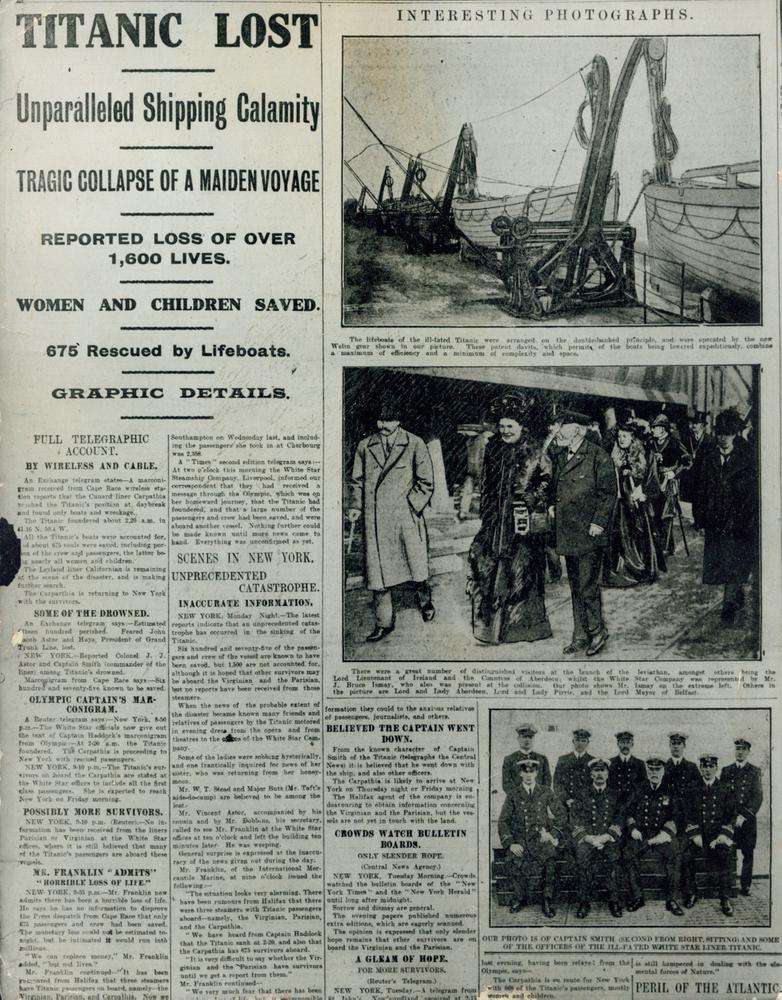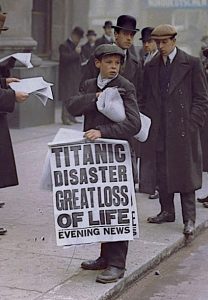
Source: Belfast Telegraph
The distress call from Titanic was greeted with disbelief and shock. News reached New York on Monday evening about the distress call. Philip Franklin, who was in charge of the White Star Line office in New York issued a statement around 10:30 pm that “There is no danger that Titanic will sink. The boat is unsinkable, and nothing but inconvenience will be suffered by the passengers.”
Messages from Titanic and other ships responding were being relayed to Cape Race and then re-transmitted on. It is during this process that things likely went amiss causing confusion. Pieces of messages got mixed up with others indicating Titanic and its passengers had been saved and was in tow to Halifax. This led to Franklin issuing another statement later that said (in part) “We hope that reports from the Virginian and the Parisian will prove to be true, and that they will turn up with some of the passengers…”Most newspapers were reporting that evening that all Titanic passengers had been saved and on various ships. Titanic was being towed to Halifax. Based on that, White Star chartered trains to take families to Halifax to meet their relatives there.
Over at the New York Times, its managing editor Carr van Anda, did not accept this. Messages from Titanic had stopped indicating it likely sank. On Monday morning, 15 April 1912, the headline of the Times had the following headline:
New Liner Titanic Hits Iceberg;
Sinking By Bow At Midnight;
Women Put Off In Lifeboats;
Last Wireless At 12:27 A.M Blurred
By midnight on the previous day, Franklin had begun to realize that something had gone terribly wrong, but it was still unconfirmed at that point. “I thought her unsinkable, and I based my opinion on the best expert advice. I do not understand it.” He would weep later when the truth would eventually be learned. As the trains sped north to Halifax, they would be stopped and turned back to New York with apologies to all aboard. The survivors were coming to New York instead. The message sent by J. Bruce Ismay from Carpathia to White Star reported Titanic had sunk. It would be learned all the survivors were aboard Carpathia bound for New York.
—
There were no such confusing reports in Ireland, Britain or elsewhere. In Belfast, those who had worked on the great ship awoke the next day to see two words on the news board the kids had to sell newspapers:
Titanic Sunk

Public Domain via Wikimedia Commons
They could not believe what they were reading. The ship they had helped build, craft, and launch was now lying on the bottom of the Atlantic. Many wept and others just stood in shock at the news. Ships back then were constructed by hand so many who had labored on the ship had a sense of pride at what they did. In Southampton, many went to the White Star Line offices to find out what had happened to their husbands, sons or daughters. White Star had lists but not great ones with just last names listed in many cases. Southampton would see many homes without fathers, mothers (or both) as a result of the Titanic. As news spread around the world, anxious families would also inquire but would not be able to learn anything.
Aboard Carpathia, Ismay isolated himself in a cabin. Wireless messages were being sent outbound by survivors aboard, but it would not respond to specific requests, even one from the President Taft of the United States inquiring about the fate of his friend and military aide Colonel Archibald Butt.
That would not be known for a few days. Carpathia was inbound to New York and only when it arrived on 18 April 1912, would they truly know who had survived and who had perished. And all that remained of that once great ship were the lifeboats that would be unloaded at the White Star Line pier.
Sources:
Books
Behe, George TITANIC: SAFETY, SPEED AND SACRIFICE, Transportation Trails, Polo, IL 1997
Eaton John P. & Haas Charles, TITANIC TRIUMPH AND TRAGEDY, SECOND EDITION, W.W. Norton & Company, New York, New York, 1995 First American Edition
Lord, Walter, A NIGHT TO REMEMBER, Holt Rinehart and Winston, New York, New York, 1955. Multiple revisions and reprints, notably Illustrated editions (1976,1977,1978 etc)
Lord, Walter, THE NIGHT LIVES ON, Willian Morrow and Company, New York, New York, 1986 (First Edition)
Lynch, Don & Marshall Ken, TITANIC AN ILLUSTRATED HISTORY, Madison Press Books, Toronto, Ontario Canada, 1992
Internet
Encyclopedia Britannica, www.britannica.com/search?query=Titanic.
“Encyclopedia Titanica.” www.encyclopedia-titanica.org.
“The Titanic: Sinking and Facts | HISTORY.” HISTORY, 12 Mar. 2024, www.history.com/topics/early-20th-century-us/titanic.



















